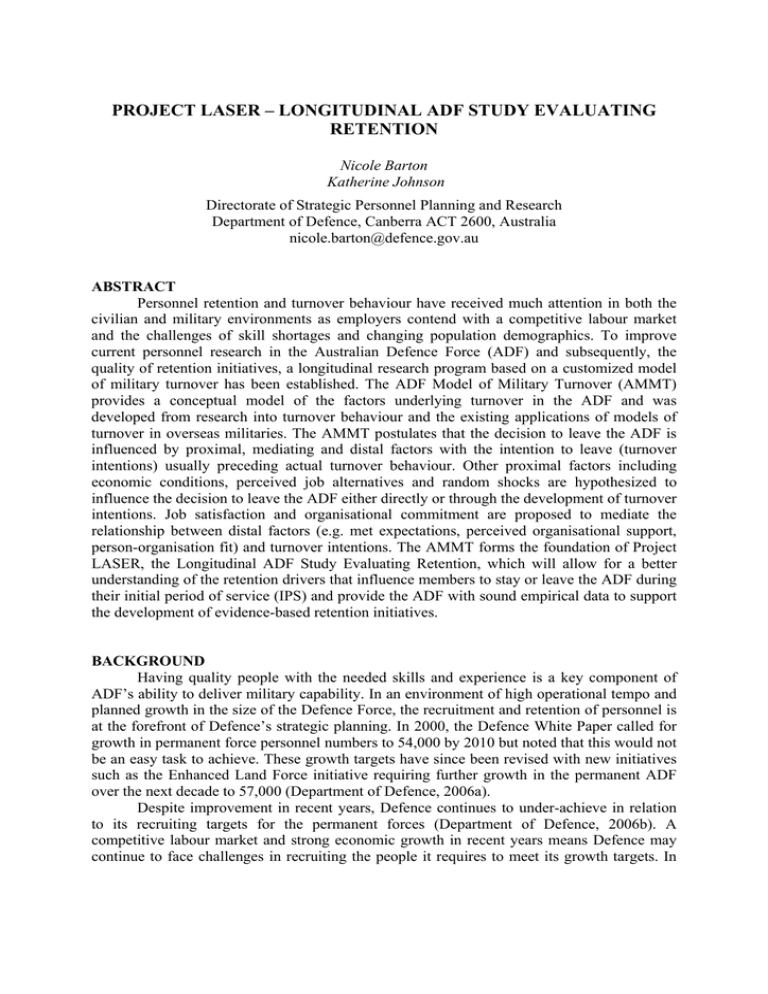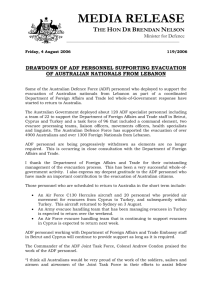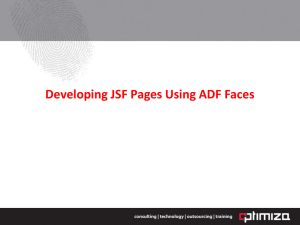PROJECT LASER – LONGITUDINAL ADF STUDY EVALUATING
advertisement

PROJECT LASER – LONGITUDINAL ADF STUDY EVALUATING RETENTION Nicole Barton Katherine Johnson Directorate of Strategic Personnel Planning and Research Department of Defence, Canberra ACT 2600, Australia nicole.barton@defence.gov.au ABSTRACT Personnel retention and turnover behaviour have received much attention in both the civilian and military environments as employers contend with a competitive labour market and the challenges of skill shortages and changing population demographics. To improve current personnel research in the Australian Defence Force (ADF) and subsequently, the quality of retention initiatives, a longitudinal research program based on a customized model of military turnover has been established. The ADF Model of Military Turnover (AMMT) provides a conceptual model of the factors underlying turnover in the ADF and was developed from research into turnover behaviour and the existing applications of models of turnover in overseas militaries. The AMMT postulates that the decision to leave the ADF is influenced by proximal, mediating and distal factors with the intention to leave (turnover intentions) usually preceding actual turnover behaviour. Other proximal factors including economic conditions, perceived job alternatives and random shocks are hypothesized to influence the decision to leave the ADF either directly or through the development of turnover intentions. Job satisfaction and organisational commitment are proposed to mediate the relationship between distal factors (e.g. met expectations, perceived organisational support, person-organisation fit) and turnover intentions. The AMMT forms the foundation of Project LASER, the Longitudinal ADF Study Evaluating Retention, which will allow for a better understanding of the retention drivers that influence members to stay or leave the ADF during their initial period of service (IPS) and provide the ADF with sound empirical data to support the development of evidence-based retention initiatives. BACKGROUND Having quality people with the needed skills and experience is a key component of ADF’s ability to deliver military capability. In an environment of high operational tempo and planned growth in the size of the Defence Force, the recruitment and retention of personnel is at the forefront of Defence’s strategic planning. In 2000, the Defence White Paper called for growth in permanent force personnel numbers to 54,000 by 2010 but noted that this would not be an easy task to achieve. These growth targets have since been revised with new initiatives such as the Enhanced Land Force initiative requiring further growth in the permanent ADF over the next decade to 57,000 (Department of Defence, 2006a). Despite improvement in recent years, Defence continues to under-achieve in relation to its recruiting targets for the permanent forces (Department of Defence, 2006b). A competitive labour market and strong economic growth in recent years means Defence may continue to face challenges in recruiting the people it requires to meet its growth targets. In this environment, retaining personnel with the right skills and experience is critical and a considered approach to personnel retention is a key priority for the ADF. It is important to remember when undertaking workforce management that some degree of turnover is functional and desirable in an organisation. Turnover provides career development opportunities for those that remain in the organisation and an opportunity for the organisation to recruit new talent. However, it is in Defence’s interests to maintain turnover at manageable levels in order to maintain capability and to avoid problems such as skills shortages and excessive training costs. It is the ability to preserve an acceptable level of turnover in the current workforce environment that presents a challenge for the ADF now and into the future. Defence’s management of its workforce will remain a critical policy area into the future. The Defence Personnel Environment Scan 2025 provides an outlook on the future personnel environment and the implications for Defence. During a time when operational tempo is likely to remain high, significant attention to personnel policy will be necessary to overcome workforce difficulties resulting from a competitive labour market and the challenges of skills shortages and changing population demographics. It is within this context that the retention of ADF personnel undergoing training, those in their first year of service and those completing their initial period of service is considered a key workforce risk. This paper outlines the ADF Model of Military Turnover (AMMT) and the development of a personnel research project – Project LASER – which is aimed at building a better understanding of the retention drivers that influence members to stay or leave the ADF during their initial period of service. THE ADF MODEL OF MILITARY TURNOVER The AMMT is a parsimonious model of employee turnover in the ADF which identifies and describes the drivers which influence a member to stay or leave the ADF (see Figure 1). The AMMT was developed specifically for the ADF context and draws on contemporary research being conducted in overseas militaries and in the field of organisational psychology (Capon, Chernyshenko & Stark, 2004; Howe, 2006; Sumer, 2005; Villeneuve, Dobreva-Martinova & Currie, 2004). The basic premise of the AMMT is that in most instances a member’s decision to stay or leave the ADF is influenced by multiple related and interdependent factors. The model also recognizes that there are some instances when random shocks (such as critical life events, sudden job offers or unpleasant incidents) may directly influence a member’s decision to leave regardless of whether they had previously formed an intention to stay or leave. According to the AMMT, once a member has consciously formed an intention to leave the ADF, job search activities will ensue. An assessment of the economic conditions relevant to job search will then occur and this assessment in turn influences the member’s perception of the job alternatives available to them. A favourable assessment of the available job alternatives will strengthen the member’s intention to leave the ADF. However, if the member’s perception of the available job alternatives is not favourable their commitment to the organisation is strengthened. A member’s turnover intentions are determined by two factors: job satisfaction; and, organisational commitment. Job satisfaction is defined as the degree to which individuals like their job and derive intrinsic satisfaction from it (Price, 2001) and is influenced by multiple factors. According to the AMMT, job satisfaction is influenced by the following factors: the degree to which the organisation meets the member’s expectations; the member’s job complexity; the member’s perception of distributive justice in the organisation; individual dispositions; the member’s relationship with their immediate supervisor; the role stress involved in the member’s job; and, the member’s perception of their current and future career opportunities within the organisation. According to the AMMT, organisational commitment is comprised of three subfactors - continuance commitment, affective commitment, and normative commitment (Allen & Meyer, 1990). In turn, organisational commitment is influenced by the following factors: the degree to which the member perceives the organisation values and cares for them; the extent to which the member and the organisation share similar values and characteristics; the member’s work-life balance; the member’s perception of procedural justice in the organisation; the member’s perception of Branch and Senior Defence leaders; the degree to which the member has a strong sense of military belonging and links to the organisation; and, the extent to which the member’s skills and training are easily transferred to alternative jobs. The AMMT will be empirically tested (as part of Project LASER) using ADF members in their initial period of service. However, it has been developed as a generic model and is thought to be applicable to ADF members at all career stages. It is anticipated that the relative influence of the various factors will vary depending on a member’s career and life stage. Figure 1. ADF Model of Military Turnover. PROJECT LASER Project LASER was developed to address the key ADF workforce risk regarding the retention of uniformed personnel undergoing training, those in their first year of service and those completing their initial period of service. Project LASER is a longitudinal personnel research program and will investigate how individual’s attitudes and expectations towards their ADF career change over time and is focused on identifying those factors which contribute to a member’s decision to stay or leave the ADF during their initial period of service. Data from Project LASER will enable the Services to develop evidence-based retention initiatives for members at risk of leaving the ADF during their initial period of service in a rigorous, systematic and defensible manner. To achieve this, a longitudinal research design using unique identifiers to track individual responses will be employed. Study participants will be surveyed as they enter the ADF, upon graduation from initial training and at regular intervals thereafter. Members who leave the (permanent) ADF during their initial period of service (including those who exit during their training) will also be surveyed (Figure 2). At Enlistment/ Appointment New Enlistee/ Appointee Survey Exit from Training Survey End Initial Training Initial Training Graduate Survey End Initial Period of Service Annual Survey Annual Survey Exit Survey Figure 2. Project LASER survey timeline. By utilising a longitudinal research design, Project LASER addresses a gap in the current personnel research knowledge for the ADF. Current personnel research fails to link reports of turnover intentions from the Defence Attitude Survey (DAS) with turnover behaviour reported in the ADF Exit Survey. Project LASER will remedy this by tracking individual members from entry into the organisation, at regular intervals thereafter and then upon exit from the organisation, thus providing the vital link between reported turnover intentions and actual turnover behaviour. By using actual turnover behaviour as the dependant variable of interest, it will be possible under Project LASER to identify the differences between ‘stayers’ (members who stay in the ADF) and ‘leavers’ (members who leave the ADF). This will lead to a better understanding of why members choose to stay or leave and in turn will allow the Services to determine how best to convert ‘leavers’ into ‘stayers’ with targeted evidence-based retention strategies and initiatives. Subjects In the first year of data collection (2008) between 40% to 50% of all new permanent force enlistees and appointees to the ADF will form the first cohort of participants. However, it is anticipated that as the project matures this will increase to 100% of permanent force enlistees and appointees to the ADF forming each cohort in subsequent years. Each cohort of participants will be followed for between four to six years (depending on their initial period of service requirements) and it is anticipated that four cohorts will be included in Project LASER. Methodology Data collection will be via a number of surveys completed at various stages of the member’s initial period of service. The New Enlistee/Appointee Survey will be completed by members on their day of enlistment or appointment in recruiting centres. This survey will capture information regarding the members’ recruitment experiences, why they have joined the ADF and who or what influenced them to join, their expectations of training and Service life, their career intentions, and baseline measures of personal dispositions, social support and stress coping. The Graduation From Initial Training Survey will be completed immediately prior to graduation from recruit training or officer training at the respective training establishments. This survey will collect information regarding the members’ experiences during training, their perceived job alternatives, their level of organisational commitment, their expectations of Service life, their career intentions and measures of social support and stress coping. Participants will also receive an Annual Survey in October/November each year after their completion of training. This survey will be administered as a supplement to the Defence Attitude Survey for those member’s participating in Project LASER. This survey will collect information directly related to the AMMT. For example, measures of perceived job alternatives, organisational commitment, job satisfaction, met expectations, leader-member relations, perceived organisational support, procedural justice and military belonging. Should participants leave the ADF during training they will receive an Exit From Training Survey administered by staff at the respective training establishments. This survey will capture information regarding their reasons for leaving, their experiences during training, the degree to which their expectations of training and Service life have been met and information specific to each training establishment. Project LASER participants will also be surveyed if they leave the (permanent) ADF after they have completed their training but prior to the end of their initial period of service. This Exit Survey will be administered as a supplement to the ADF Exit Survey and will capture information such as: reasons for leaving, career perceptions and experiences and future career intentions. Unique identifiers will be used to track participants and match their responses across the various surveys. Participants will be offered incentives to complete and return their annual survey. However, the incentives offered will not be on a one-for-one exchange basis. When participants return their completed annual survey they will go in a draw for the chance to win one of a number of prizes such as movie tickets or gift vouchers. It is hoped that this will assist in keeping response rates high and encourage participants to remain active in the study. A Project LASER intranet site is also planned. This website will provide an opportunity for the research team to actively engage the participants and provide them with regular updates on how the project is progressing. Participants will have the opportunity to provide feedback to the research team, seek feedback about how the information they have provided is being used by the Services to assist in the development of retention policy initiatives and to update their personal details should they change. Again, it is hoped that this will assist with the engagement of participants and encourage them to remain active respondents in the study. CONCLUSION A climate of strong economic growth, high operational tempo and strategic guidance which requires substantial growth in force numbers presents the ADF with a number of workforce challenges and risks. Retention of ADF personnel, particularly those undergoing training and during their initial period of service has been identified as one of the key workforce risks facing the ADF. In response to this workforce risk, a new personnel research program has been developed aimed at building a better understanding of the retention drivers that influence members to stay or leave the ADF during their initial period of service. Project LASER and the AMMT represent an important and exciting personnel research program for the Directorate of Strategic Personnel Planning and Research (DSPPR) and the ADF. A longitudinal research program of this nature and size has not been attempted before and there is much anticipation from the Services that Project LASER will enable them to develop evidence-based retention policy initiatives in a rigorous, systematic and defensible manner. REFERENCES Allen, N.J. & Myer, J.P. (1990). The measurement and antecedents of affective, continuance and normative commitment to the organization. Journal of Occupational Psychology, 63, 1-18. Capon, J., Chernyshenko, O.S., & Stark, S.E. (2004). Applicability of civilian retention theory in the New Zealand military. Paper presented at the 46th Annual Conference of the International Military Testing Association, Brussels. Department of Defence (2000). White Paper: Defence 2000 – Our Future Defence Force. Commonwealth of Australia. Department of Defence (2006a). Australia’s National Security: A Defence Update. Commonwealth of Australia. Department of Defence (2006b). Defence Annual Report 2005-2006. Commonwealth of Australia. Department of Defence (2006c). Defence Personnel Environment Scan 2025. Directorate of Strategic Personnel Planning and Research Report 27/2006. Howe, D. (2006). Building and sustaining a retention culture in the Canadian Forces. Director Personnel Generation Requirements Attrition/Retention Team (DPGR A/RT), Canada. Price, J.L. (2001). Reflections on the determinants of voluntary turnover. International Journal of Manpower, 22, 600-621. Sumer, H.C. (2005). A model of military turnover. Paper presented at the 47th Annual Conference of the International Military Testing Association, Singapore. Villeneuve, M., Dobreva-Martinova, T. & Currie, G. (2004). Buying low attrition or building high retention? That is the question. Director Military Employment Policy Attrition/Retention Team (DMEP A/RT) Report, 2004-06, Canada.





